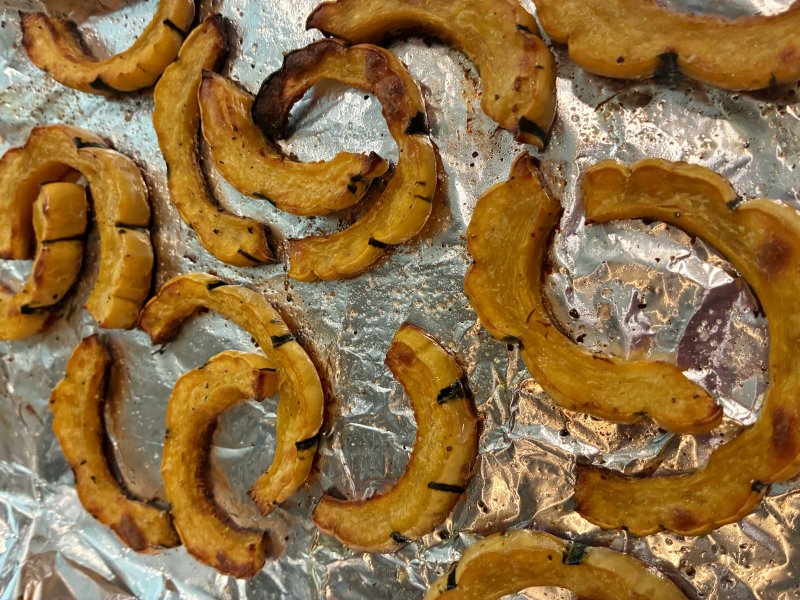If you read this column with any regularity, you may have noticed that I often talk about the names of specific ingredients or dishes. This week, the focus is on a varietal known as “delicata” squash. It is cylindrical in shape, creamy in color and highlighted with lengthwise green stripes on its grooved skin. It is also called peanut squash because of its elongated shape or sweet potato squash for its sweet, milld flavor.
Although seasonally a winter squash, it has a thin skin like summer squash and zucchini, and it does not require the curing step to harden the skin and sweeten the flesh like other winter squashes. Delicata as a cultivar was first introduced in the United States in the 1890s by the Peter Henderson Company of New York. This variety waned in popularity during the Great Depression because it was susceptible to disease.
Thanks to the plant scientists at Cornell University, a mold- and mildew-resistant type was developed in the late 1900s. Called Cornell’s Bush Delicata, this varietal grows in a bush habit rather than on a vine, reducing the space farmers and home gardeners need to cultivate it. Since its reintroduction, it has become quite popular and is available at farmers markets and grocery stores in our area.
Key features of delicata are firm, thick, fine-grained flesh that is yellow to orange in color and a hollow central cavity containing stringy pulp and flat, hard seeds. When choosing delicata squash, look for those with no signs of bruising, nicks, blemishes or cuts. Store them in a cool, dry place for up to three months. Do not keep them in the refrigerator, as that will encourage mold or mildew to form.
Delicata squash can be difficult to cut because of its dense flesh. One approach is to soften it in the microwave (about 2 minutes on high), then allow it cool before cutting and seeding. The next step is to slice it in half and then remove the seeds. Use a grapefruit spoon if possible, since its serrated edges help scrape away seeds and strands from the narrow cavity.
Slice the squash lengthwise if you want to use it as a boat to be stuffed with a savory filling. Also go lengthwise if you want to form half-moons, as in the photo. If you cut it in half crosswise and scoop out the seeds from each half, you can slice it into rings. Once you’ve chosen your recipe, you’ll know which way to prepare the squash. And, be sure to save the seeds to roast with a drizzle of olive oil, salt and pepper, or sweetened with maple syrup and cinnamon.
I’ve included a simple recipe for roasted delicata squash. This can easily be modified to feature additional flavors such as sage, thyme or parsley — simply sprinkle the slices with the herbs of your choice. Another option is to combine oregano with grated Parmesan cheese and lemon zest for a bright topping. This recipe calls for olive oil, but you can always substitute melted butter.
The other recipe is a delicata squash filled with ground lamb seasoned with cumin and cinnamon, a wonderful foil to the sweet flesh of the roasted squash. You can use this same filling in butternut or acorn squash, or the last of your summer zucchini.
Roasted Delicata Squash
Preheat the oven to 425 F. Line a rimmed baking sheet with aluminum foil; set aside. Cut the squash in half lengthwise and scrape out the seeds; discard or save to roast.
Slice the squash crosswise into 1-inch-thick slices and place them in a large bowl. Drizzle the squash with olive oil, tossing to coat. Arrange half-moons on the baking sheet in a single layer. Sprinkle with salt and pepper; roast until golden brown, 25 to 30 minutes, flipping the slices halfway through. Serve warm or at room temperature.
Yield: 4 servings.
Lamb Stuffed Delicata Squash
























































